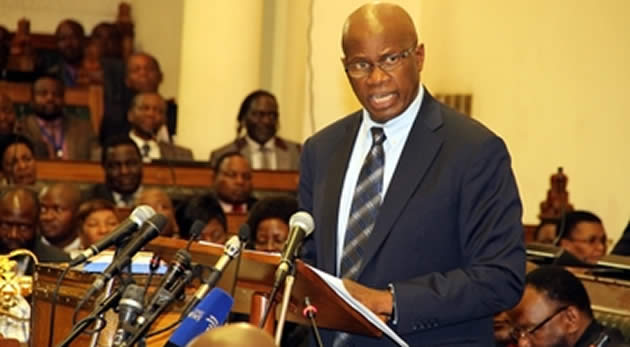


 ZIMBABWE’S banking sector has been hit with massive withdrawals by risk-loathing depositors over the past five months, with banking sector sources indicating that reports of a return of the domestic currency have further unsettled bank customers. The Zimbabwe dollar was banished from circulation in 2009 to stem a hyperinflationary crisis that plunged the economy into an unprecedented catastrophe characterised by commodity shortages.
ZIMBABWE’S banking sector has been hit with massive withdrawals by risk-loathing depositors over the past five months, with banking sector sources indicating that reports of a return of the domestic currency have further unsettled bank customers. The Zimbabwe dollar was banished from circulation in 2009 to stem a hyperinflationary crisis that plunged the economy into an unprecedented catastrophe characterised by commodity shortages.
A source from one top bank said since December last year, most businesses have been transacting in cash and avoiding the banking sector. He said this is likely to have resulted in an overall shrinkage in deposit levels within the banking sector. “I have not noticed any panic withdrawals as a result of reports of a Zimbabwe dollar return, but since December, many people have been preferring cash transactions and avoiding banks,” said the source.
Total banking sector deposits amounted to US$4,73 billion as at December 31, 2013, according to latest statistics from the Reserve Bank of Zimbabwe (RBZ). This was an increase from deposit levels of US$3,84 billion in June 2013. Deposits have since the adoption of a hard currency economy grown slowly due to a combination of factors. These factors include low deposit rates being offered by banks, which the RBZ says have conspired with high bank charges to militate against efforts geared at broadening the country’s deposit base.
An acceleration of deposit withdrawals is likely to worsen a liquidity crunch in a country desperate for cash to revive an economy back in intensive care after stabilising briefly when government adopted a hard currency regime. Another banking sector source said liquidity in the banking sector was “gradually thinning.” He suggested that this could have something to do with reports of the Zimbabwe dollar’s resurgence.
Panic over the comeback of the Zimbabwe dollar would be regardless of assurances from government that it would not bring back the local currency into circulation soon, despite a liquidity crunch certain to impede government business unless a rescue package is secured. Another banking sector source said deposits were plummeting due to significant withdrawal levels by the corporate sector.
“Individual deposits had always been in transit anyway; people were using bank accounts to receive money and immediately make withdrawals because of the low confidence levels due to historical issue. But we have witnessed corporates making withdrawals and at times almost keeping their accounts with zero balances,” said a banker who declined to be named because he is not authorised to speak to the press.
He said the fact that five biggest banks by deposits had much of their money stashed in nostro accounts betrayed the banking sector’s fear of a near-term return of the Zimbabwe dollar. The Zimbabwe Revenue Authority (ZIMRA) commissioner-general, Gershem Pasi, told a Parliamentary Portfolio Committee on Foreign Affairs last month that local banks were keeping large amounts of money in their nostro accounts, exacerbating the liquidity crunch in the economy.
“We realise banks through their nostro accounts are keeping huge sums of money than necessary to meet their obligations,” said Pasi. A nostro account is a bank account held in a foreign country by a domestic bank, denominated in the currency of that country. Nostro accounts are used to facilitate settlement of foreign exchange and trade transactions. Banks say they keep large sums of money in their nostro accounts to settle international payments, such as use of Visa and Mastercard by their clients, as well as other obligations.
The policy uncertainty in the country also necessitated cash holdings in these accounts for settlement of credit line facilities, said one bank executive, agreeing that offshore lenders were not sure about government’s pledge to stick to the currency hard currency regime. The African Development Bank (AfDB) said in a report last year that increasing depositor speculation over the possible return of the Zimbabwe dollar had hit deposit levels.
“Depositors are said to fear the return of the Zimbabwe dollar, in which they lack confidence,” said the AfDB report after noting a decline in money supply growth in May last year, which it said would be temporary “if authorities provide credible guarantees of the continued existence of the multi-currency regime”.
Sources within both the banking sector and industry suggest government had in October last year printed large amounts of Zimbabwe dollars after panic over funding of the 2014 budget. Finance Minister Patrick Chinamasa, who has vigorously denied reports that government is contemplating bring back the Zimbabwe dollar into the economy, postponed the budget presentation from the traditional month of November, and at one time suggested this would be presented before January 18 due to consultative processes. The national budget was, however, presented on December 19.
In his national budget presentation, Chinamasa said there was a sharp shrinkage in money supply in the economy. The year on year growth in money supply stock stood at 3,61 percent as at October 31, 2013, compared to 24,9 percent as at October 31, 2012. Accordingly, he said, money supply stock, as at October 31, 2013, stood at US$3,951 billion, highlighting a serious liquidity hitch.
The banking sector source indicated that a recent clamp down on defaulting tax payers by ZIMRA had also resulted in slower usage of the banking system. ZIMRA, anxious to plug a growing funding hole in Treasury, has issued garnishee orders on bank accounts for hundreds of institutions, including small businesses.